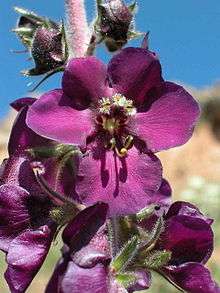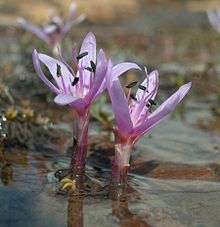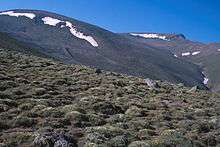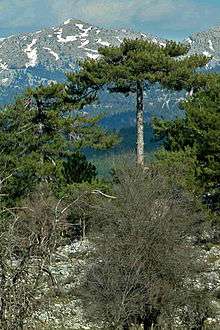Flora of Turkey

In the year 2000 about 9300 species of vascular plant were known for the area of the Turkish Republic. By comparison, Europe as a whole contains only about 24% more species (about 11500), despite having thirteen times the area.[1]
The most important reasons for Turkey’s high plant biodiversity are believed to be the relatively high proportion of endemics in combination with a high degree of climatic and edaphic variety.
Endemism

DAVIS & al. (1988) calculated that nearly one third or Turkish plant species (30,6%) is endemic to Turkey and the nearby Aegean Islands. For Austria the respective value is meagre 1,56% and for the British Isles it is still lower. Moreover, none of the endemic British species is taxonomically remote from a non-endemic species. An ultra-conservative taxonomist might therefore unite all the endemic species with none-endemic ones, thus reducing endemism on the British Isles to 0%. On the other hand, rates of endemism are also highly dependent on the surfaces of compared areas and their delimitations. In order to achieve better comparable data we might unite the surfaces of Germany and France, thus obtaining an even larger area than Turkey. But the estimated proportion of endemics still would remain much lower, with Germany alone having about the same low proportion as Austria.
One reason for this relative importance of endemism in the Turkish flora is the mountainous and at the same time rather strongly fragmentised surface of Anatolia. In fact the Anatolian mountains resemble archipelagos like the famous Galapagos Islands. Since Darwin we know that geographic isolation between islands or separated mountains is an important means of speciation, leading to high spatial diversity. For Anatolia this assumption is conformed by concentrations of endemism on highly isolated and relatively old massifs as Uludağ or Ilgaz Dağ, whereas very young volcanic cones as Ercyes Dağ or Hassan Dağ are surprisingly poor in endemics.

.
As the evolution of local endemics is a rather lengthy process, we have to consider also the different histories of central or north European mountains and the Anatolian ones. During each of the glacial periods the former were covered by thick shields of permanent ice. Thereby pre-glacial endemism was mostly destroyed and the forming of neo-endemics hindered. Only less glaciated, peripheral areas, the so-called “massifs de refuge”, offered suitable conditions for the survival of local endemics during glacial periods. In Anatolia ice cover during Pleistocene glaciations always remained restricted to the highest peaks. As a logical consequence, species with small distribution-areas are a rather common phenomenon in many parts of the country. In other words: Anatolia as a whole is a big “massif de refuge”, showing all degrees of past and recent speciation.
Ecologic diversity
For a visitor from Central Europe climatic diversity within Turkey is quite astonishing. On a somewhat smaller scale all climatic zones of Europe can be found. The Black Sea coast is humid all the year round, with the highest rainfall between Rize and Hopa. South of the Pontic Range rainfall drops abruptly and in Central Anatolia dry and winter-cold conditions prevail. Approaching the southern and western coasts, the climate turns more and more Mediterranean, with mild but very rainy winters and dry, hot summers. This simple scheme is complicated a lot by the mountainous surface of Anatolia. On the high mountains harsh climatic conditions persist all the year round. There are even small glaciers on the north side of Cilo Dağ and on Mount Ararat.
Also in regard to edaphic conditions Anatolia’s diversity is astonishingly high. Saline soils are rather common in the driest parts of central Anatolia. But also the Aras valley between Kağızman and the Armenian border is full of impressive salt outlets, some pouring directly out of the mountains and thus resembling snow patches from the distance. In the regions south of Sivas and around Gürün large areas of Gypsum hills are to be found with a very special flora. A further lot of endemics have been described from the extensive serpentine areas in South-West Anatolia, especially from Sandras Dağ (Cicekbaba D.) near Köyceğiz.
It has been found that there is a dividing line, known as the Anatolian diagonal, which runs slant-wise across central and eastern Turkey from the northeastern portion of the Mediterranean Sea to the southeastern part of the Black Sea. Many species of plant that exist west of the diagonal are not present to the east, while others found to the east are not present to the west. Of 550 species analysed, 135 were found to be "eastern" and 228 "western".[2] Besides the Anatolian diagonal forming a barrier to floral biodiversity, about four hundred species of plant are endemic to the diagonal itself.[3]
Main components of the Turkish flora


Considering species numbers Astragalus (milk-vetch, goat's-thorn; Fabaceae) is by far the most important genus of the Turkish flora. This may be explained by its predisposition to treeless, dry and heavily grazed habitats. Their extension augmented drastically due to human activities in historical times. Still more Astragalus species are reported from central Asia. The flora of the former UDSSR contains about 800 species. The plasticity of this genus is astonishingly high. Depending from environmental conditions a big variety of life-forms evolved, reaching from tiny annuals to small woody and thorny bushes. Speciation seems to be in plain progress in Astragalus. Nearly each of its different sections consists of clusters of closely related species whose determination is one of the hardest tasks in a closer study of the Anatolian flora. One of the most successful growth forms of Turkish Astragali is the thorn cushion, which is very characteristic for the dry mountains of inner Anatolia. Such thorn cushions were not exclusively invented by many Astragali. Really striking examples of convergent evolution are the impressive thorn cushions of Onobrychis cornuta, also belonging to the Fabaceae. But there are a lot of thorn cushions also in Acantholimon (Plumbaginaceae). Even some Asteraceae (in Turkey e.g. Centaurea urvillei, C. iberica) and Caryophyllaceae (e.g. Minuartia juniperina) evolved in that direction. Second in importance comes Verbascum (Scrophulariaceae) and third is Centaurea (Asteraceae). For Verbascum Turkey evidently is the centre of distribution. From approximately 360 species worldwide not less than 232 are to be found in Turkey, 79,4% of them being Anatolian endemics! Most Verbascum species are protected against water losses and hungry cattle by a dense cover of tree-shaped micro hairs. Centaurea species rarely have woolly hairs, but in defence against heavy grazing developed thorny phyllaries or evolved to acaulous forms.
Vegetation

Along the northern border of Anatolia the Pontic Range forms a more or less continuous barrier against humid air from the Black Sea, causing high precipitations on the northern slopes of the Pontus during the whole year. Climatic conditions on the northern coast therefore resemble those in central Europe and so does the vegetation. A limited Mediterranean influence is noticeable only on a very narrow coastal strip, but almost completely missing in the North-East. In the lower forest zone often Hornbeam (Carpinus betulus) prevails, frequently intermingled with Sweet Chestnut (Castanea sativa). Further up Oriental Beech (Fagus orientalis) and/or Nordmann Fir (Abies nordmanniana) form extensive forests. Humidity becomes extremely high in Lazistan, where the Pontic barrier culminates in the nearly 4000 m high Kackar Daği. East of Trabzon therefore vegetation becomes somewhat sub-tropic, with a lot of evergreens on the forest grounds and tea plantations everywhere on the slopes.
South of the Pontic watershed the climate immediately gets drier. In the mountains first Abies nordmanniana, but then soon Pinus becomes dominant. In the western parts of Anatolia this is often Black Pine (Pinus nigra), in the east nearly exclusively Scotts Pine (Pinus sylvestris). Penetrating further into the central parts of inner Anatolia leads to still dryer, wintercold conditions. Today the lower parts of central Anatolia are virtually treeless. Fields on deep alluvial soils alternate with steppe on the dryer hills. But it is still an open question where and to what degree this central Anatolian steppe is due to aridity or to human forest destruction. Aridity is most pronounced around Tuz Gölü south of Ankara und and in the Aras-valley near the Armenian border. Between Kağizman and Tuzluca this valley is so dry, that here and there pure salt deposits are glittering like white snowfields from the bare slopes.
The Taurus Range forms the southern limit of the central Anatolian Plateau. Mediterranean influence is already very pronounced there, with a lot of snow in winter, but dry and warm summers. Climax forests are formed by Black Pine, Cilician Fir (Abies cilicica) and Lebanon Cedar (Cedrus libani). Unfortunately there has been a lot of deforestation in the Taurus, most gravely affecting the stands of Cedrus. On the Aegean and Mediterranean coasts pronounced Mediterranean conditions prevail, with very hot and dry summers and very rainy winters. Antalya has considerably more total precipitation than London (1071 mm versus 759 mm), but its seasonal distribution is completely different and average temperature is of course much higher (18,3 °C versus 9,7°). Such conditions favour the growth of hard-leaved evergreen trees such as Kermes Oak (Quercus coccifera) and Turkish Pine (Pinus brutia). But due to massive forest destruction today hills and slopes in coastal West and South Anatolia mostly are covered with macchie. Where fertile alluvial soils prevail, e.g. in the Cilician Plain around Adana, there is intense agriculture.
 Picea orientalis with Abies nordmanniana and Fagus orientalis on the moist northern slopes of Kaçkar Dağ (Northeastern Pontus). Main component of the scrub between the trees is Rhododendron luteum, above Ayder, c.1700 m s.l.
Picea orientalis with Abies nordmanniana and Fagus orientalis on the moist northern slopes of Kaçkar Dağ (Northeastern Pontus). Main component of the scrub between the trees is Rhododendron luteum, above Ayder, c.1700 m s.l. Scotts Pine (Pinus sylvestris) is the dominant tree in the dry and cold areas of north-eastern Anatolia, southern slope of Kücükhacet Dağ (Ilgaz Dağ), c.1950 m s. l.
Scotts Pine (Pinus sylvestris) is the dominant tree in the dry and cold areas of north-eastern Anatolia, southern slope of Kücükhacet Dağ (Ilgaz Dağ), c.1950 m s. l. Rest of the Anatolian steppe with Crambe tatarica (white), with fields in the background, Ahiboz, c.35 km south of Ankara, c.1000 m s.l.
Rest of the Anatolian steppe with Crambe tatarica (white), with fields in the background, Ahiboz, c.35 km south of Ankara, c.1000 m s.l. Semidesertic vegetation in the Aras-valley near the Armenian border. Sparse plant cover consists mainly of drought- and salt-tolerant members of the Goosefoot Family (Chenopodiaceae), 35 km west of Tuzluca, 1110 m s.l.
Semidesertic vegetation in the Aras-valley near the Armenian border. Sparse plant cover consists mainly of drought- and salt-tolerant members of the Goosefoot Family (Chenopodiaceae), 35 km west of Tuzluca, 1110 m s.l. In Turkey the cultivation of tea is confined to the almost subtropical part of the Black Sea coast around Rize, Ikizdere valley south of Rize, 200 m s.l.
In Turkey the cultivation of tea is confined to the almost subtropical part of the Black Sea coast around Rize, Ikizdere valley south of Rize, 200 m s.l. Orchards with hazelnuts (Corylus maxima) are very typical for the mountainous parts of the Anatolian Black Sea coast. East of Trabzon they give way to tea plantations, near Terebolu (Giresun-Province), c. 20 m s. l.
Orchards with hazelnuts (Corylus maxima) are very typical for the mountainous parts of the Anatolian Black Sea coast. East of Trabzon they give way to tea plantations, near Terebolu (Giresun-Province), c. 20 m s. l. Turkish women drying hazelnuts, Sacmalipinar (Düsce-Province).
Turkish women drying hazelnuts, Sacmalipinar (Düsce-Province). In 2007 Turkey took the 7th place in world cotton production. Cotton grows best in hot, sunny regions but needs plenty of water, near Belek (Antalya-Province).
In 2007 Turkey took the 7th place in world cotton production. Cotton grows best in hot, sunny regions but needs plenty of water, near Belek (Antalya-Province).
See also
References
- ↑ "Turkey's flora and fauna". allaboutturkey.com. Retrieved 12 June 2014.
- ↑ Ekima, T.; Günera, A. (1989). "The Anatolian Diagonal: fact or fiction?". Proceedings of the Royal Society of Edinburgh. Section B. Biological Sciences. 86: 69–77. doi:10.1017/S0269727000008915.
- ↑ Münir Öztürk; Khalid Rehman Hakeem; I. Faridah-Hanum; Recep Efe (2015). Climate Change Impacts on High-Altitude Ecosystems. Springer. pp. 280–283. ISBN 978-3-319-12859-7.
AVCI. M. 2005. "Çeşitlilik Ve Endemizm Açısından Türkiye’nin Bitki Örtüsü-Diversity and endemism in Turkey's Vegetation", İstanbul Üniversitesi Edebiyat Fakültesi Coğrafya Bölümü Coğrafya Dergisi 13:27-55.
Information for this article was taken mainly from Gerhard Pils: Flowers of Turkey - a photo guide.- 448 pp.– Eigenverlag Gerhard Pils (2006).
Further basic literature about Turkish Flora and Vegetation:
- DAVIS, P. H. ed. 1965-1988: Flora of Turkey and the East Aegean Islands, 10 vols.− Edinburgh: University Press.
- GÜNER, A. & al. 2000: Flora of Turkey Supplement 2 [= vol 11].− Edinburgh: University Press.
- KREUTZ, D.A.J. 1998: Die Orchideen der Türkei, 766 pp.− Landgraaf (NL): Selbstverlag.
- MAYER, H. & AKSOY, H. 1986: Wälder der Türkei.– Stuttgart & New York: G. Fischer Verlag. Contents as pdf
- KÜRSCHNER, H., RAUS, T. & VENTER, J. 1995: Pflanzen der Türkei. Ägäis - Taurus - Inneranatolien.− Wiesbaden: Quelle & Meyer. Contents as pdf
- PILS, G., 2013: Endemism in Mainland Regions – Case Studies: Turkey.- p. 240-255 in: HOBOHM, C. (Ed.): Endemism in Vascular Plants.- Springer Verlag
- SORGER, F. 1994: Blumen der Türkei.− Stapfia (Linz) 34. [pdf, 21,54Mb]
- TURKISH JOURNAL OF BOTANY